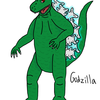HOME | DD
 GodzillaLagoon — Walking With Dinosaurs Rebooted: Diplodocus baby
GodzillaLagoon — Walking With Dinosaurs Rebooted: Diplodocus baby

#cute #diplodocus #dinosaur #documentary #paleoart #prehistoric #sauropod #walkingwithdinosaurs #dinosaurart #paleoillustration #sauropodomorpha
Published: 2024-02-23 15:26:32 +0000 UTC; Views: 5573; Favourites: 102; Downloads: 0
Redirect to original
Description
Diplodocus hallorum (hatchling)Bio:
While sauropods like Diplodocus were true titans of the land, like many other things in this world, they started out small. Young sauropods, also known as sauropodlets, all were born from round hard-shelled eggs the size of football ball. While each sauropod species had its own ways of nesting, with some being solitary while the others had common nesting sites used by generations of sauropods, some things were shared among all long-necked giants. Once a hundred or so eggs were laid, the mother sauropod would leave her offspring to probably never meet it again. This moment marked the beginning of future giants' life and a flow of hardships that followed it.
The life of a young sauropod wasn't easy. Even before hatching they already entered the world of danger, with all the opportunistic predators eager to feast on rich sauropod clutch. Those who managed to hatch were since then thrust into a challenging world where survival was a constant struggle. The hatchlings, no larger than a cat, had to quickly learn to navigate their environment and evade predators that lurked around.
Their growth was rapid, and within two decades, these once tiny sauropodlets transformed into colossal giants that shaped and transformed the ancient landscapes. They faced numerous challenges along the way, from finding enough food to avoid predators and navigate the changing terrain. Despite the odds stacked against them, some managed to survive and thrive, eventually becoming the awe-inspiring giants that dominated the prehistoric world.
As they grew, their bodies underwent remarkable changes, adapting to support their massive size and unique lifestyle. Their long necks stretched to reach the treetops, their powerful legs supported their weight, and their sturdy bodies allowed them to withstand the rigors of their environment. Each day brought new challenges and experiences, shaping them into the magnificent creatures that continue to captivate our imagination today.
Role in the series:
Diplodocus acts a a focus animal of the second episode of Walking With Dinosaurs titled Time of the Titans. One of the main storylines of the episode is a chronicle of life of a female Diplodocus, starting with her birth and culminating in her first mating season.
The female Diplodocus along with her siblings was first seen hatching from a clutch of eggs laid several months ago. As it turns out, the clutch was discovered by Ornitholestes, who was devouring the dead sauropodlets. Thanks to this fact, a lot of sauropodlets managed to escape safely to the forest undergrowth. The female had to take a rest but she quickly joined her siblings in the forest thicket.
Once sauropodlets found a place to hide, they quickly start consuming all the plant they could reach, a habit that will allow them to grow to gigantic sizes in the future, if they manage to live long enough. As sauropodlets are eating, the Ornitholestes passes by. Diplodocus hatchlings instinctively take cover by laying motionless and letting their protective skin patterns hide them from a theropod. While predator gets fooled this time, very often its sharp eyes find its prey.
Background:
As you certainly noticed, this is the first time I'm making more than one drawing for a single species. The reason is quite simple as juvenile Diplodocus take a major part of episode's story, with a whole storyline dedicated to the journey of young sauropods to the adulthood. Besides, baby Diplodocus have separate promo image and model (along with several other animals), so it felt natural to give them their own piece (or rather pieces but more on that later).
While the adult Diplodocus wasn't particularly challenging in terms of general understanding and rather presented the challenge of accurately displaying it, babies presented a different challenge. Because, unlike with Titanosaurs, we have surprisingly little information about Diplodocids in this regard. There are currently no known fossilized nests or even single eggs and hatchling fossils. So, this piece is rather speculative, since I had to reference titanosaur fossils for this. Nonetheless, I think I came close to how Diplodocus hatchling should actually look, especially when compared to corgi-like juveniles of the original.
The other challenge I faced was coloring. The original coloration for juvenile Diplodocus had intricate camouflaging patterns that were not only hard to get right, since not much of the material showed them properly, but to translate to significantly different anatomy of the updated juveniles. But I dope I did it right nonetheless.
That's all for now, folks! Stay tuned for the updates as there's a lot for us to unpack!
Walking with Dinosaurs is owned by BBC and Impossible Pictures
Related content
Comments: 3

👍: 0 ⏩: 0

👍: 0 ⏩: 1

👍: 0 ⏩: 0

















